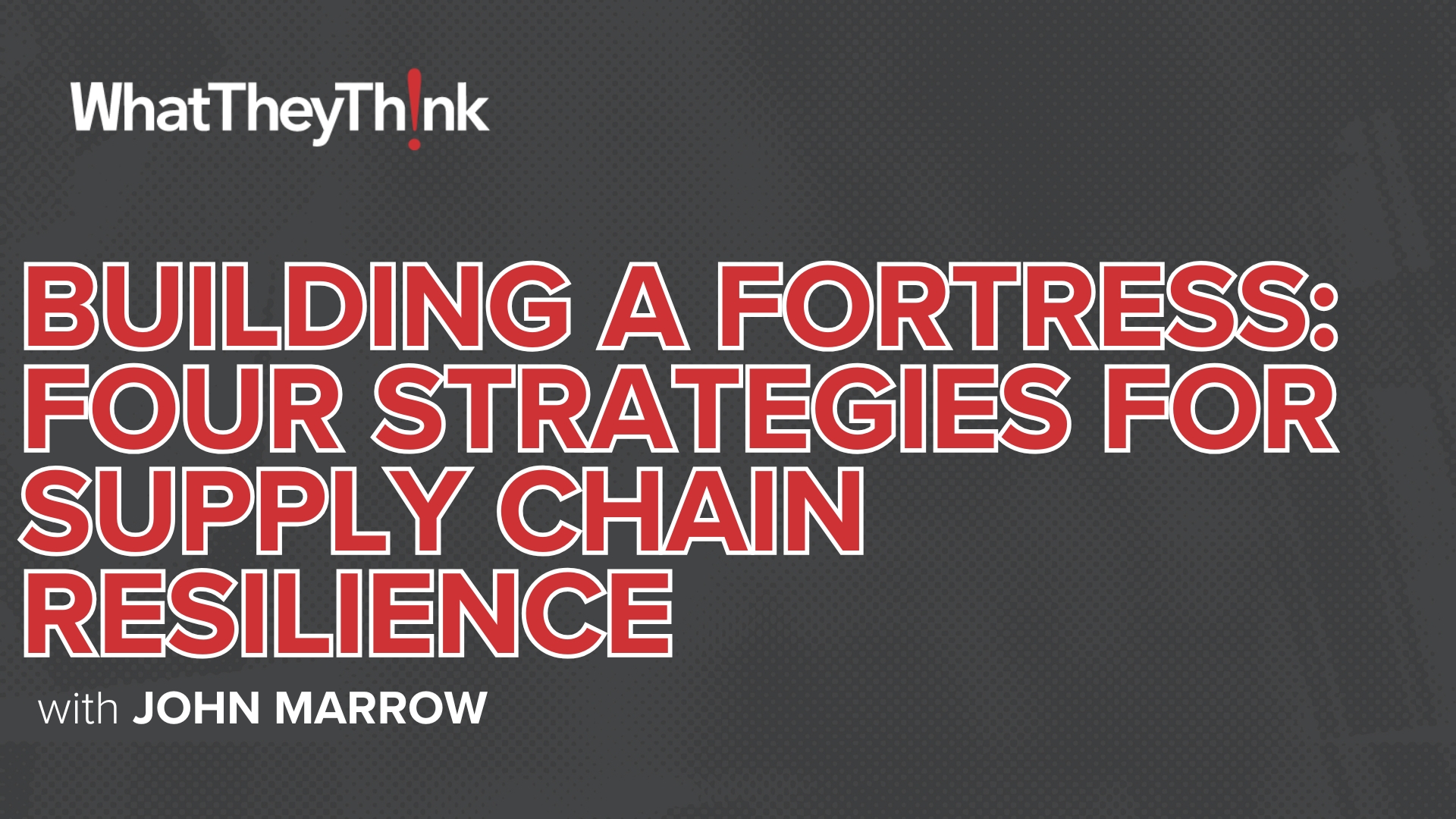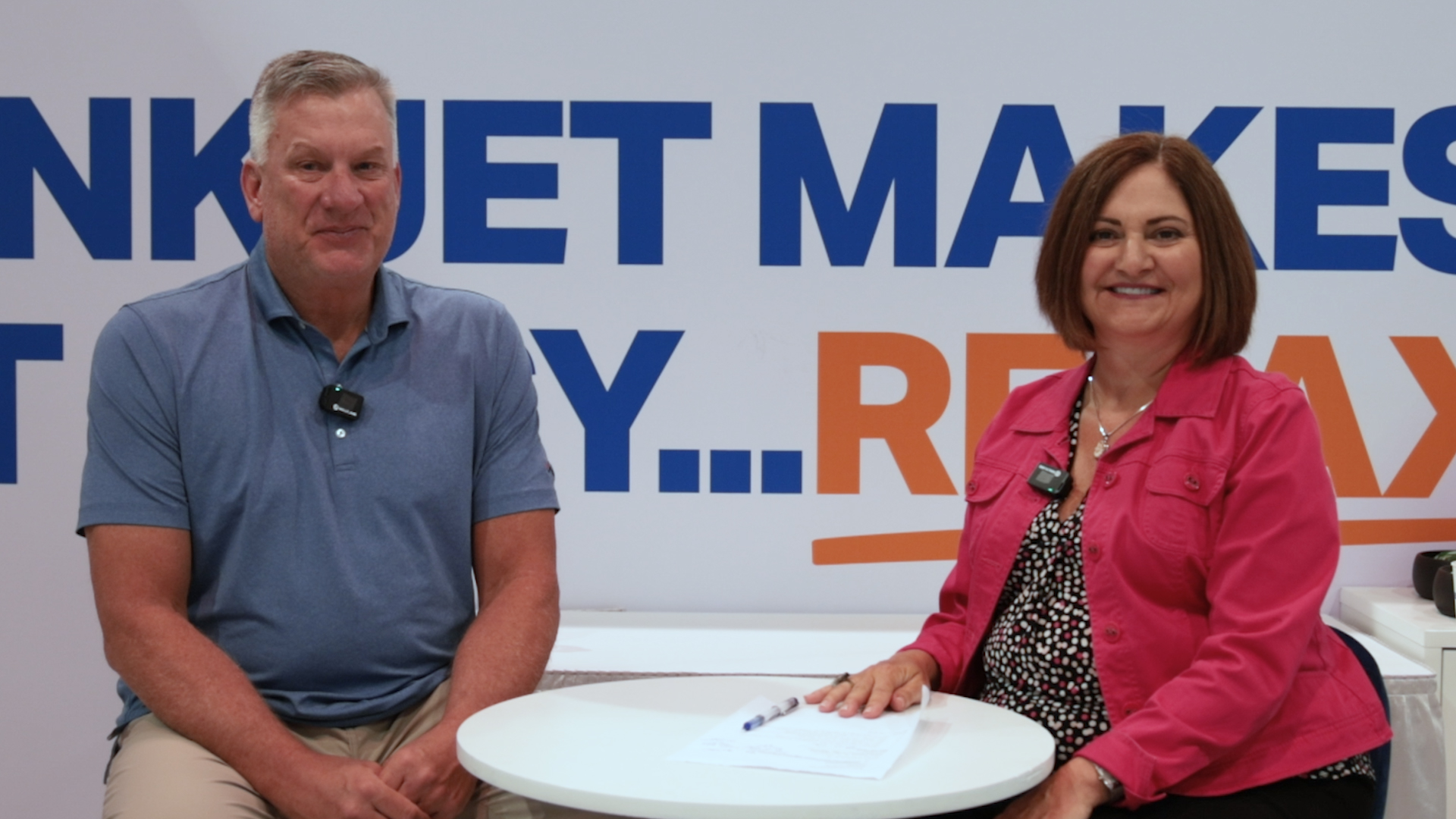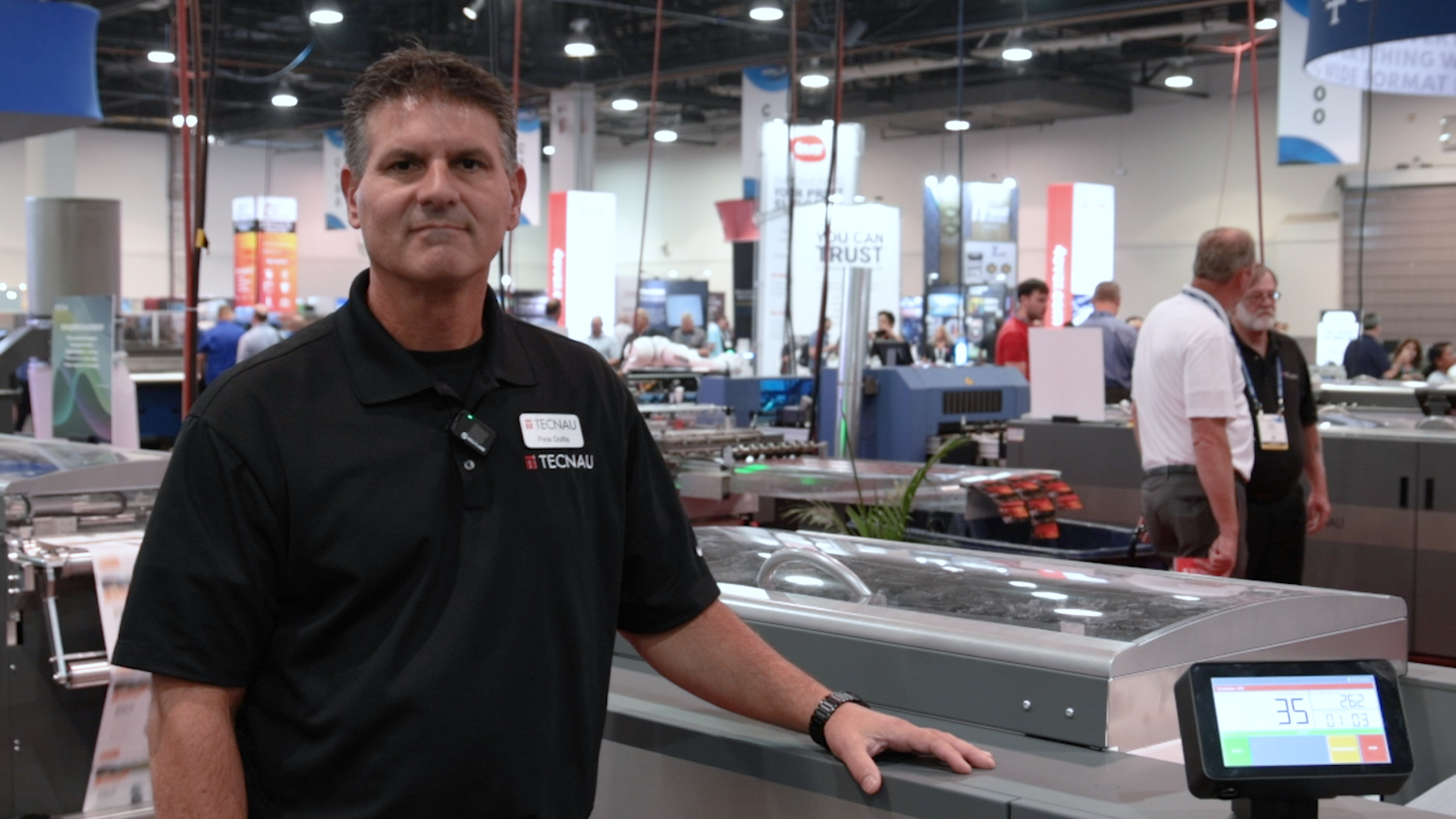Commentary & Analysis
Displaying 701-800 of thousands of articles
Insight You Need. Analysis You Trust.
Get the trusted insights you need to understand our evolving industry and emerging trends. Become a Premium Member.
Hot Off the Press: 2023 B2B Buyer’s Survey
The old saying, “Content is king” has never been more true, especially in the B2B world. Heidi Tolliver-Walker takes a look at DemandGen’s 2023 B2B Buyer’s Journey survey.
Putting Inkjet in Reach for More In-Plant Printing Operations
In-plant printing experts agree that production flexibility is increasing in importance and inkjet can help operations to adapt. In this article, sponsored by Kyocera, Lois Ritarossi interviews Christopher Donlon of the IPMA and Mark Fallon of the Berkshire Company and discusses the accessibility of inkjet printing for in-plant printing operations of all sizes.
Corrugated Packaging: Designing for the Future
E-commerce is growing fast and needs to better focused on customers’ packaging needs. The movement and transport of product is very different for e-commerce than it is for brick-and-mortar applications. As a result, there is probably a need to have its own channel-specific solutions.
Building Your Crisis Recovery Playbook
Our industry has a lot of names for the process of cleaning up when something happens that disrupts the normal flow of business. Disaster recovery planning is a common term, along with business continuity planning, emergency response planning, and crisis recovery. We have learned that the need for a planned response evolves from events of every size. Are you ready?
Turnover and Employment in Print in Europe—Portugal
This bi-weekly series of articles aims at shedding a spotlight on the size of the printing industry in Europe per country and how revenues and employment developed in 2020, when the pandemic impacted businesses. This time we look at Portugal, the 15th-largest printing industry by turnover in Europe.
Are Cooling Fabrics the Next Hot Thing in Apparel?
As Earth continues to heat up, brands, retailers and consumers alike are looking for innovate cooling technologies for textiles and apparel, and there are a number of them already on the market. As we note in this article, however, this is very much a “buyer beware” market, as not all cooling fabrics appear to operate as promised. Read on to learn more.
Remembering John Warnock
John Warnock the American computer scientist, inventor, and technology businessman best known for co-founding Adobe Systems Inc died on August 20, 2023.
Printing Establishments—2010–2021
According to the latest, just-released edition of County Business Patterns, in 2021 there were 22,580 establishments in NAICS 323 (Printing and Related Support Activities). This represents a decline of 22% since 2010. In macro news, July retail sales came in above expectations.
Around the Web: ’Zine Zone. Conference Carousels. Voice Verse. CAPTCHA Conclusion. Deadly Dishes. Calculator Collection. Brick Brainwaves. Potent Potables. Bottle Brouhaha.
"Print" magazine’s list cool independent print magazines. What company presentations were like before PowerPoint. Telepoem booths are popping up in the Southwest. A wearable mouse. The robots have cracked CAPTCHA. AI-based recipe bot creates toxic meals. Greg Maletic’s collection of vintage calculators. Scientists have reconstructed Pink Floyd’s “Another Brick in the Wall” by analyzing people’s brainwaves. The James Webb Space telescope zooms in on the most distant detectable star. Dunkin’ introduces boozy iced teas and coffees. Pro tip: don’t age wine at the bottom of the ocean. All that and more in WhatTheyThink’s weekly miscellany.
Standing Out with Visually Appealing Direct Mail
Direct mail marketing remains effective due to its ability to stand apart from a vast array of online marketing messages. Its tangible format provides an excellent opportunity for businesses to make a long-lasting impression on their desired audience. This article explores how visually appealing direct mail designs can maximize the effectiveness of your direct mail campaigns.
Designing a New Future: The Next Generation Has the Power to Make a Positive Impact
In this article, originally posted on the Pixel to Parcel blog and provided compliments of textiles expert and WhatTheyThink contributor Debbie McKeegan, the role of the next decade's designer is explained. As a creative, the designer must now onboard a deeper understanding of the product’s components, the manufacturing process, the data and information held within the supply chain, and the final product’s subsequent circularity in order to deliver a product with a defined and credible plan for end-of-life. This will soon be regulatory. Designers should be preparing today for this new focus.
Mariano Rivera Foundation’s Print Design & Packaging Development Program Adds New Custom Training Program for Commercial Printers
The Mariano Rivera Foundation and its Print Design & Packaging Development (PDPD) program started primarily to train service technicians in the vendor space but has since evolved into a custom training program for printers. Heidi Tolliver-Walker looks at what the program has accomplished in the past year.
The Production Inkjet Evolution: Ricoh Production Inkjet
In 2011, I began a series that looked at the then-current production inkjet vendor product offerings, and over the years continued to look at how they were being, or could be, used. In this new series, 15 years later and with drupa 2024 on the horizon it’s time to take a look at how production inkjet has evolved, how it is used and where we can expect it to go and grow. I will look at each of the production inkjet manufacturers and suppliers, customers and document some of their journeys. In this article I look at Ricoh Production Inkjet.
Finding and Developing Talent for the Printing Industry
At the top of the list of printing industry issues is a lack of skilled labor. The only difference now is that the shortage it is getting more severe and is affecting the pool of non-skilled labor as well. European section editor Ralf Schlözer looks at Germany’s vocational training initiative and the challenges it faces in supplying talent to the printing industry.
Get More from Your Print Operations
By optimizing costs and resolving bottlenecks, the print industry can bring more efficiency to its business, resetting print economics and getting more from its print production. Let’s do it! Process automation increases productivity, helps to control bottom-line costs, and can add hidden capacity. In this article, sponsored by Baldwin Technologies, see how Baldwin solutions are based on decades of experience bringing insights to printing companies with data and automation. See how they can help you conquer today’s challenging print industry economics.
Profit and Loss—Smithers Reviews US Print Demographics to 2028
The US printing industry is in a period of profound transition, posing new challenges for leaders at all stages of the value chain. Traditional print segments are declining sharply, new commercial opportunities are emerging, but often require strategic reorganization of businesses and equipment assets. How this ecosystem will evolve across the next five years is one of the main topics in the latest report “The Future of Printer Demographics to 2028” from Smithers.
Don’t You Hate Mosquitos? Help is On the Way!
Mosquitos are the biggest killer on the planet, killing more than 725,000 people per year. That’s more than humans, snakes, dogs, and other creatures. But help is on the way. Researchers at North Carolina State University have done groundbreaking research on insect-proof textiles. Learn more!
Tales from the Database: Take Me to Your Leader!
Drawing on six years’ worth of Print Business Outlook surveys, our “Tales from the Database” series looks at historical data to see if we can spot any particular hardware, software or business trends. This issue, we turn our attention to leadership.
Johnson’s World—Pause, Plan, and Proceed
Leaders don’t always have the option of taking as much time as they need to carefully plan and implement their strategies…or do they? Steve Johnson explains how in business we often really do have the luxury of taking the time we need to research, plot, and launch our next moves.
Around the Web: Language Loss. Menu Maven. Bogus Books. Translation Tool. Freakish Photos. Animal Armor. Door Dilemma. Tuba Terror. Taco Trademark. Menacing Melons.
Typefaces can play a role in keeping old languages alive. Henry Voigt is the premier collector of historical American menus. Author discovers AI-generated fake books listed in her name on Amazon. A 3D-printed heart ventricle beats on its own. Toppan’s VoiceBiz UC (Universal Communication) Display is a real-time translation device. Spend time perusing and being horrified by “Terrible Real Estate Photographs.” 3D-printed graphene-enhanced ballistic armor for service animals. Door handles “semantically designed to be clear about the direction the door should be opened.” A chainsaw-powered, flame-throwing tuba will liven up any marching band. Taco John’s relinquishes “Taco Tuesday” trademark, in a win for alliteration. Watch out for foaming, exploding watermelons. All that and more in WhatTheyThink’s weekly miscellany.
ICYMI: Number One: Allen Printing Company Tops the List of Small Commercial Printers
Allen Printing Company has been a regular fixture of our “Top 10” for at least the past five years, and this year finally moved into the number-one spot. Richard Romano talks with COO Paul Heffington.
Company Culture: Good Leaders Exist Throughout Your Team
Leadership can be defined as, “providing a great place for great people to work.” Contributor David Fellmann identified how leaders can foster healthy company cultures and avoid unhealthy ones.
2023 Top 100 Small Commercial Printers
Each year, WhatTheyThink invites small commercial print business owners to participate in our “Top 100 Shops Survey.” In this article, Richard Romano looks at the results of the Top 100 survey—and announces this year’s winner: Nashville’s Allen Printing Company.
Run the World: Gender Diversity Is Good for the Bottom Line
There is a growing body of research suggesting that companies with a higher percentage of women on their leadership teams tend to perform better financially than those with fewer women in leadership positions. This phenomenon is not simply a matter of fairness or equity. It appears to be directly linked to improved business outcomes.
From T-Shirts to Airplanes: SPESA’s President Michael McDonald Highlights the Sewn Products Industry’s Advances and Challenges
SPESA, the Sewn Products Equipment and Suppliers of the Americas, is an industry association that represents suppliers to the industry, and plays a key role in the ability to streamline supply chains, bring textiles work back to the Americas, find more ways to automate the sewing process, and attract new talent. Cary Sherburne talks with SPEA president Michael McDonald.
Developing a Leader: Cheryl Kahanec, CEO of Quantum Group, Knows What It Takes to Face Challenges Head On
Cheryl Kahanec, CEO of Quantum Group, is an industry-recognized expert in digital technology and solutions as well as a frequent speaker who has been featured and quoted in many leading industry publications. Julie Shaffer catches up with her to talk about leadership.
Balancing Act: Maintaining Well-Being Elevates Your Leadership Potential
Joanne Gore identifies the characteristics of a good manager and how they contribute to a positive and productive work environment. At the same time, focusing on well-being and self-care can help employees become better leaders.
Help Wanted: Building a Performance-Based Culture Starts with Better Hiring Decisions
Print businesses today have a need for significant efforts to improve productivity to offset a shrinking and increasingly expensive labor market. The purpose of the article is to develop an understanding of how involved and time-consuming leading this effort can be.
Reduce, Reuse, Rethink: Sustainability Isn’t a Linear Issue—It Requires a More Circular Approach
Printed products are varied, as are the processes used to create them. The focus on design, production, use and disposal of these products will continue to be scrutinized in the context of a circular economy as environmental pressures increase. Since print is a complex of interconnected processes, there are many areas that could be affected by sustainability efforts and the measurement of the carbon footprint. How do you measure what ‘could’ reach into every aspect of the printing business, from process, to people, to profitability?
The Target Report: 116 Laps Around Fenway Park, Barefoot—July 2023 M&A Activity
Maine Newspapers Acquired by Nonprofit Trust, and more…
Welcome to the Leadership Issue
This week, we are publishing the content from Issue 4, the Leadership Issue. In this article, a preview of the week’s content.
Beating the Odds: Print Franchise Operations Show Double-Digit Growth in 2022
Cary Sherburne takes WhatTheyThink’s annual look at the state of the print franchises. 2022 was truly a recovery year after a very difficult business environment during the pandemic. Nowhere was this more evident than in the franchise networks serving the printing industry.
The Magic Bus: Canon’s Francis McMahon on Leadership
We caught up with Francis McMahon, executive vice president at Canon Solutions America, Production Print Solutions, who spoke about his leadership style, how he came to adopt that style, what being a “corporate hippie” means, and how he is helping the next generation of company—and industry—leaders.
A New Playbook: When What You’re Doing Is No Longer Working, It’s Time for a New Plan
There are unprecedented generational changes as Gen X, Gen Z, and millennials become a greater percentage of our workforce and begin to assume leadership positions. This new workforce has a very different set of perspectives and expectations from their work experience. Ken Garner looks at how these challenges and new realities are impacting your workplace and enterprise, and introduces the “Peak Performance Series.” It’s a fact-based introduction to the leadership skills and competencies required to achieve peak performance when the world is volatile, uncertain, complex and ambiguous.
All Other Converted Paper Product Manufacturing Establishments—2010–2020
According to County Business Patterns, in 2020 there were 360 establishments in NAICS 322299 (All Other Converted Paper Product Manufacturing). This category saw a net decrease in establishments of -22% since 2010. In macro news, Q2 GDP is up.
Around the Web: Type Tracking. Tome Tech. Paper Presentation. Clever Clicker. LiFi Love? Auto Annoyance. Missed Molding. Wool War. Killer Kreme.
Interactive WaPo story tests font legibility. AI will not disrupt books. “Possibilities of Paper” is an art installation featuring creative uses of paper. A tribute to the Zenith Space Command remote control. There is such a thing as “LiFi,” light-based wireless communication. VW is reintroducing its “magic bus”—and it’s electric. Car owners are frustrated by the proliferation of technology in cars. Dang, we missed the National Week of Injection Molding. The James Webb Space Telescope spots a giant cosmic question mark. Why not participate in the annual Sheep to Shawl Competition? In “dip hop,” rappers lay down rhymes in sign language. Krispy Kreme has filled doughnuts with M&Ms, for some reason. All that and more in WhatTheyThink’s weekly miscellany.
The Digital Textile Market Flourishes as Home Décor and Furnishings Embrace Advanced Printing Technology
In this article, compliments of textiles expert and WhatTheyThink contributor Debbie McKeegan, she provides an update on digital textile printing via Future Markets research, and also explains why increased interest in custom home and interior décor is poised to further spur market growth for digital textile printing. Digital share for digital textile printing still hovers around 10% of all printed fabric.
The Changing Role of Marketing Communications in a Digital-First World
Keypoint Intelligence recently conducted its 2023 direct marketing communications primary research to better understand how businesses’ direct marketing practices are changing over time. This article offers a brief overview of the top-level results from this year’s survey. It discusses the transition to paperless communications, the ongoing focus on customer experience, and how business marketing practices are changing over time.
In Search of Label Revenue? Venture to “The Other Side of the Tracks”
Looking to get into label production? Be aware of the distinction between commercial and industrial labels. Heidi Tolliver-Walker explains the distinction—and how the latter could be the far more profitable market.
How Does It Feel? The Missed Opportunity of Embellishments
Some highlights from the recent Taktiful/WhatTheyThink “2023 Specialty Digital Ink and Toner Embellishment Study” shows how digital press users can get the most out of their specialty ink and toner options, and points toward how printers can take advantage of the broader universe of “embellishments.”
Digital vs. Offset: Debunking Definitive Crossover Claims
What is the digital and offset economic crossover point? It’s not a straightforward question. Inkjet Insight’s Elizabeth Gooding provides highlights of a recent expert panel discussion that discussed the various criteria that contribute to determining the “sweet spot” for the crossover of offset to inkjet.
Turnover and Employment in Print in Europe—Hungary
This series of short articles aims at shedding a spotlight on the size of the printing industry in Europe per country and how revenues and employment developed in 2020, when the pandemic impacted businesses. This time we look at Hungary, the 13th-largest printing industry by turnover in Europe and third largest in Central and Eastern Europe.
Zaikio: Progressing in Procurement
European section editor Ralf Schlözer takes a look at the current state of Zaikio, and its recent integration of a procurement app that can aid or fully automate supplies ordering processes.
May Shipments Take an Unexpected—But Welcome—Turn
May 2023 printing shipments came in at $7.26 billion, unexpectedly up from April’s $7.01 billion.
Around the Web: Prop Printer. Postal Pop. Comic Coding. Edgy Eraser. Geographic Geometry. Borax Bane. Cap’n Correction.
The Earl Hays Press has provided virtually all printed props for the film industry since 1915. A typewriter made out of drums. A musical PSA from 1967 explaining the ZIP code. A useful, less egregious version of Comic Sans. “An innovative eraser with 5 edge sizes in one implement!” What are the world’s most rectangular or roundest countries? Two words: cocaine sharks. A new TikTok fad involves consuming or bathing in borax, for some reason. ExxonMobil invests in carbon capture. Quaker Oats finally fixes Cap’n Crunch’s uniform. All that and more in WhatTheyThink’s weekly miscellany.
Off the Wall Cases: ISA Webinar Highlights New Issues in Sign Regulation
Last month, the International Sign Association hosted a webinar presented by the Sign Research Foundation that looked at the current legal lay of the land pertaining to sign codes. Some of the cases looked at were old favorites (Reed v. Town of Gilbert, et al.), but some new recent cases have raised entirely new issues—specifically concerning murals, and whether they are considered art or signage.
Simplifying the Digital Textile Print Process: Does Wet-On-Wet Print Technology Offer a Gateway to One Step Digital Textile Printing?
The latest developments in digital textile printing vastly reduce the factory footprint for technology while also reducing (if not removing altogether) the need for ancillary machinery. Wet-on-wet printing is widely recognized as one of the main facilitators in this simplification. WhatTheyThink contributor Debbie McKeegan takes a deep dive into wet-on-wet, one-step textile printing solutions.
Beach to Bay Heritage Area Holotwins Are Live
Heidi Tolliver-Walker looks at how the Beach to Bay Heritage Area used augmented reality holotwins to engage visitors and enhance their experiences in key areas of interest.
Turnover and Employment in Print in Europe—Austria
This bi-weekly series of short articles aims at shedding a spotlight on the size of the printing industry in Europe per country and how revenues and employment developed in 2020, when the pandemic impacted businesses. This time we look at Austria, the tenth-largest printing industry by turnover in Europe.
The Artificial-ness of Generative AI
Have you tried ChatGPT, Bard, or another generative AI technology? They use algorithms to respond to prompts, leveraging available data pools to provide responses. They can be taught to respond to almost anything that can be broken down into steps. And they can make mistakes. Are you ready?
Kyocera’s Expanding Footprint
Kyocera’s intention is clear: they are moving into the production print industry, and while they may be new to selling inkjet presses in this market, they have 30 years of expertise in developing ink and material jetting solutions, and an impressive track record at that. In this article, sponsored by Kyocera, David Zwang looks at their recent initiatives.
Getting to Carbon ZERO
A recent Axios newsletter was headlined “No safe port in a climate storm.” In this article, Senior Editor Cary Sherburne looks at some of the recent extreme events attributed to climate change, as well as greenwashing, greenwishing, and greenhushing, more buzzwords for your vocabulary. She highlights some of the projects that are underway to reduce greenhouse gas emissions on the way to getting to Carbon ZERO…a state we are not likely to reach for some time, but progress, however slow, is being made.
Around the Web: Fresh Font. Colonial Currency. Timeless Textiles. Cool Calendar. Food Fossils. Mennonite Machines. Hammock Hanger. Scream Search. Movie Mashup. Cake Crash.
Microsoft 365 has a new default typeface. Benjamin Franklin vs. counterfeiters. A Japanese textiles company still uses 40-year-old software. A wall-mounted E Ink-based calendar that syncs with Google Calendar. A new museum exhibit focuses on “food archaeology.” Electric bikes are popular among…the Amish? A fast-deploying portable hammock. The original “Wilhelm scream” has been found. Opening today: “Barbenheimer.” Hostess introduces the Ding Dongs x Twinkies Mashup. All that and more in WhatTheyThink’s weekly miscellany.
Sanitary Paper Product Manufacturing Establishments—2010–2020
According to County Business Patterns, in 2020 there were 123 establishments in NAICS 322291 (Sanitary Paper Product Manufacturing). This category saw a net decrease in establishments of -13% since 2010. In macro news, new business applications continue to rise.
Marketing in the Age of Data Overload
Data analytics is essential in modern marketing. It enables marketers to make more informed decisions about their strategies by providing valuable insights into customer demographics, interests, and behaviors. As marketers intensify their efforts, they must remain mindful of today’s staggering volumes of data. This article explores the challenges that direct marketers face with data management and how they can address them.
There Is No Turning Back: ITMA 2023 Marked a Significant Turning Point For Textile Innovation, AI, and Creativity
This article, complements of textiles expert and WhatTheyThink contributor Debbie McKeegan and the Pixel to Parcel blog, reports that ITMA 2023 in Milan marked a significant turning point for textile innovation, AI, and creativity. In fact, this article was created using AI, with search terms recycling, fashion, and environmental! It covers the need for the textiles and apparel industry to step up its action on reducing its environmental footprint and preparing for an onslaught of regulatory changes over the next few years. Read on!
How Hard Do You Look at Your Talent?
Contributor Wayne Lynn explains in depth how to evaluate how your business is performing by creating a “composite” client and building a situation where a company has declining performance driven mostly by issues with customers and salespeople. The body of this article is a memo written to the owner of this hypothetical client.
ESG Practices: More Than Just Another Acronym?
Contributor Heidi Tolliver-Walker looks at Environmental, Social, and Governance (ESG) practices—a set of criteria that measure a company’s performance and impact on critical environmental, social, and ethical issues—and how they apply to print businesses.
The Production Inkjet Evolution: Canon Continuous Feed
In 2011, I began a series that looked at the then-current production inkjet vendor product offerings, and over the years continued to look at how they were being, or could be, used. In this new series, 15 years later and with drupa 2024 on the horizon, it’s time to take a look at how production inkjet has evolved, how it is used, and where we can expect it to go and grow. I will look at each of the production inkjet manufacturers and suppliers, customers and document some of their journeys. In this article, I look at the journey of the Canon continuous-feed line.
Ink, Sustainability, and Regulatory Challenges
A raft of legislation under the European Green Deal has been, or is planned to be, implemented by the EU to make society more sustainable. The activity with the biggest impact on the printing and packaging industry is the Packaging & Packaging Waste regulation. European section editor Ralf Schlözer looks at the issues involved in and potential impacts of these new laws.
Scratching the Itch of Customer Engagement: Reimagining a Decades-Old Solution to Boost Event Experiences
Contributor Joanne Gore looks at how a decades-old print application—scratch-off cards—are being used in combination with interactive technologies to create more immersive experiences for trade shows and other events.
Around the Web: Keyboard Carousing. Perishing Paper. Hammer Happiness. Album Art. Calming Canines. Automotive Aviation. Fungus Funeral. Auteur Adventure. Condiment Collection.
Milwaukee’s inaugural QWERTYFEST celebrates the invention of the typewriter. The world’s oldest national newspaper has produced its final print edition after 320 years. “People are paying to break printers with sledgehammers in smash rooms.” Graphene-based “e-skin.” Aqualamb brings back album art in the age of streaming. Noise-canceling headphones for dogs. The flying car is almost here! Italian automotive hackers create the lowest drivable car, for some reason. Mushroom-based coffins for the burgeoning “green burial” trend. Enter “Tim Burton’s Labyrinth.” Burger King’s “real cheeseburger.” All that and more in WhatTheyThink’s weekly miscellany.
June Printing Production Employment Up Slightly, Non-Production Down
Overall printing employment in June 2023 was down -0.2% from March. Production employment was up 0.4% while non-production employment was down -0.6%.
Meeting Ever-Shorter Turnaround Demands in the Wide Format Market
The ever-increasing demand for immediate delivery is creating some unique challenges for today’s print service providers (PSPs). Wide-format print jobs have become especially challenging because they often require a great deal of customization, personalization, and design modifications. This article discusses some top strategies that can help PSPs to manage the turnaround expectations of today’s print buyers.
Want Pixel-Perfect Prints? Make Color Management a Priority
In a digital world, many expect color management to be an exact science, a simple and automatic function of the print process—simply place your on-demand order, and voila—your print arrives on time and just as you imagined it. But unfortunately, that’s far from true. In this article, complements of textiles expert and WhatTheyThink contributor Debbie McKeegan and the Pixel to Parcel blog, color management—and how to get it right, first time, every time—are explained.
ICYMI: Printers Share Their Workflow Automation Success Stories
Patrick Henry takes a deep dive into the myriad ways print businesses are implementing workflow automation, the tools they are using, and the results they have achieved. The range of what printers have accomplished indicates how much becomes possible once a plant commits to workflow automation.
Eurolabel Embraces GEW ArcLED Technology in Transition to UV LED
GEW’s latest customer case study explores why Eurolabel, a successful label printing company on the outskirts of Milan, embraced GEW ArcLED. Eurolabel employs almost 80 employees and an annual turnover of around €12 million. Learn why they embraced GEW’s ArcLED technology.
Want to Improve Productivity? Increase Employee Engagement
According to Gallup, 59% of employees are “quiet quitting” and 18% are “loud quitting,” or fully disengaged. The result? Low productivity, poor performance, and high risk of turnover. Fortunately, there are some simple things employers can do to re-engage employees and turn things around.
Turnover and Employment in Print in Europe—Finland
This bi-weekly series of short articles aims at shedding a spotlight on the size of the printing industry in Europe per country and how revenues and employment developed in 2020, when the pandemic impacted businesses. This time we look at Finland, the 14th largest printing industry by turnover in Europe and the second largest in the Nordic region.
Social Profiles Are Forever
Estate planning, succession planning, and getting our affairs in order are part of life. If you run a business, the process of planning for the next generation or next owner is part of the process. In our personal lives, we tend to look at the big things to make sure assets are identified and that there is a plan for how they will be handled in the future. We’re talking about what happens when someone dies, whether it is anticipated or unexpected. Here are some things to add to your list.
Executive Q&A: Kyocera’s Jose Maria Estebanez
WhatTheyThink European Section Editor Ralf Schlözer talks with Jose Maria Estebanez, Vice President of Corporate Marketing for Kyocera, about the company’s first production inkjet press, the TASKalfa Pro 15000c.
The Target Report: Stick to Your Knitting—June 2023 M&A Activity
Lakeside Acquires Marquis, and more…
Accurate Printing of Color-Critical Materials Essential to Printing Success
Since the early days of digital color printing, color management has been a struggle for many. And some struggle even in the analog world. Although the presses have improved, including significant color management automation, it can still be difficult to get everything right, especially when it is necessary to exactly match color across multiple press types—analog and digital—as well as to ensure good color representation in digital files often used during the proofing cycle. We spoke with Meredith Nichols, a certified color management and workflow automation consultant, and a member of the Color Management Group, about how she works with clients and why certifications are important.
Other Converted Paper Product Manufacturing Establishments—2010–2020
According to County Business Patterns, in 2020 there were 483 establishments in NAICS 32229 (Other Converted Paper Product Manufacturing). This category saw a net decrease in establishments of -20% since 2010. In macro news, BEA revises Q1 GDP up.
Around the Web: Clever Katherine. Magazine Massacre. Cool Curtains. Lens Literature. Lawn Loathing. Canine Conflagration. Barbie Buildings. Beverage Bling.
The only woman’s name that appears on the Declaration of Independence. National Geographic lays off its last remaining staff writers. Turn your walls or windows into huge, animated Lite-Brites. The Sol Reader is essentially a Kindle embedded in a pair of glasses. Making “smart paper” with liquid metal. A graphene-based wearable and wireless patch that detects signs of liver inflammation. A design firm’s war against…lawns. The new face of terror: a robotic dog with a flamethrower attached to its back. Barbie’s Dream House in each state. Is a 2,000-year-old Pompeiian fresco the oldest depiction of a pizza? 7-Eleven introduces Slurpee-themed jewelry, for some reason. All that and more in WhatTheyThink’s weekly miscellany.
ICYMI: Wrapper’s Delight: High School Senior Wins Bus Wrap Design Contest
For the last three years, Laketran in Lake County, Ohio, has held a student Design-a-Bus Wrap contest, sponsored by Avery Dennison. This year’s winner was Mentor High School senior Kaitlin Barninger. Richard Romano looks at how this year’s winning design came about.
Digital Certification for the Textile Printer—Latest Developments: The EU Digital Passport and Reborn
Green-washing, green-wishing, and any terminology in between no longer washes. Consumers are becoming more aware of the damage the textile industry does to the planet. The industry must quickly reevaluate the fashion supply chain. Ethically conscious consumers evaluate their purchase decisions around the sustainability and traceability of the manufactured product. To evaluate the integrity of these products, the consumer must rely on the quality of the certification provided to reinforce their choice. Gone are the days when buzz words like “eco-friendly,” “organic,” and “sustainable” will suffice. See how the EU Digital Product Passport may help in this article compliments of textiles expert and WhatTheyThink contributor Debbie McKeegan.
Product Spotlight: Getting Product Personalization Right with LiveArt
Consumers are no longer satisfied with only buying mass-produced products. Online and brick-and-mortar print shops have offered B2B and B2C buyers the ability to customize printed products, but the process is sometimes complex and hard to understand. Pat McGrew looks at LiveArt’s web-to-print services which address the gap between off-the-shelf web-to-print solutions available in the market and the growing needs of printers requiring more custom-tailored solutions for their clients.
At Wise, Lean Is Not Just “A” Strategy for the Business; It’s “The” Strategy
Want more productivity, higher levels of efficiency, and greater profitability? Automation is one way to get there, but lean is, too. In this Q&A, Bill Prettyman, CEO of Wise, discusses why lean is no longer a strategy for the business. It’s become the strategy for the business.
LeadingPRINT Summit Looked at All Aspects of Print Industry Leadership
APTech’s LeadingPRINT Summit, held June 14 and 15 at the Westin O’Hare in Rosemont, Ill., featured two days of formal presentations and informal discussions of the biggest challenges facing the industry and how to address them. The event was capped off by a tour of Morton Grove, Ill.’s Quantum Group. This article recaps the event.
Gallus’ Expandable Ecosystem Designed for Future Growth
The previously announced Gallus One digital label press is more than just an “all in one” label press, jointly developed by Gallus and Heidelberg. It is at the core of an expandable ecosystem designed for the industry’s digital future and the new normal.
Why Consider Professional Services for Your Mission Critical Projects?
The temptation is always there. How hard can it be to handle a new project, an assessment, a business plan, or strategy development on your own? Why pay a consultant or another organization to come in and do work that you know you and your team can do? Clearly it will be less expensive to handle the requirements between the production work, maintenance, and client care! Or, is it? Let’s investigate!
When Automation Revolutionizes Your Business
The significant investments Documation has made in workflow and finishing equipment has completely revolutionized its business. Jeremy Stanek, Documation’s Vice President of Operations, explains.
Intergraf’s Print Matters for the Future Conference 2023 Looks at Industry Megatrends
Print Matters is an annual conference, organized by Intergraf, the European association of the national print associations, and the Nordic Printing Association NOPA. The 2023 conference took place in Riga, Latvia, and focuses on some of the most pressing issues of the European printing industry. European section editor Ralf Schlözer runs down the highlights of the presentations.
April Shipments Maintain Seasonality—Just as We Feared
April 2023 printing shipments came in at $7.00 billion, down from March’s $7.58 billion and in line with annual seasonality—although it is a bit below the previous two Aprils.
Around the Web: Bewildering Bots. Commemorating Kafka. Mac Merch. Paper Peeping. Analog Attraction. Freed Feline. Netflix Noshing. Planet Pondering. Tamer Tippling.
A “public service videogame” that invites players to verify images incorrectly to confuse bots. Type designer and typographer Oded Ezer’s unique “The Samsa Enigma” project for the 140th anniversary of Franz Kafka’s birth. A knitted blanket based on the original Mac OS desktop. Behind the scenes at Seven Days, a Vermont-based weekly newspaper. The continuing resurgence of non-digital technologies. A kitten is rescued from a packaging recycling container. Converting a pickup truck into a giant dot matrix printer. Could life exist on Venus, of all places? When out at the bar, be sure to adjust for drinkflation.” All that and more in WhatTheyThink’s weekly miscellany.
All Hail the Power of Print: Digital Textile Innovations Abound at ITMA, Milan 2023
All hail the power of print, for ITMA didn’t disappoint. Packed with innovations at all levels, the show proved to be an incredible success. Visitor numbers reached 111,000 from an impressive 143 countries, and exhibitors peaked at 1,709 spread across an incredible 200,000 square meters of exhibition space. The venue was well organized, easy to reach, and well-serviced; and for those that exhibited and those that visited, was credited as a truly successful experience. Textiles expert and WhatTheyThink contributor Debbie McKeegan shares her perspective.
Paper Maintains Its Appeal Among General Office Workers
Even in the digital age, paper remains essential for many office workers. This article cites recent research from Keypoint Intelligence to illuminate how today’s office workers are interacting with paper. It also explores paper’s particular appeal among younger office employees.
The Darker Side of AI: It’s Up to Us to Avoid It
For our industry, AI offers up a powerful tool for things like workflow connectivity, analytics, and shop floor data analysis, as well as development of marketing content. But there are legitimate fears around AI, as well. When it comes to addressing those fears, it remains an individual effort.
Gamechanger and Online Print Booster: 30 Years of PDF
From the World Wide Web to cloud services, technological developments in recent decades have fundamentally changed industry and business—and with them the work and processes in print shops. However, one small tool, or rather file format, is often overlooked in the list, even though data exchange in general and online printing in particular would not work as we know it today. We’re talking about PDF, the Portable Document Format, which turns 30 this year—and has been with me for just as long. Time to talk about its history and its importance to printing.
Epson Brings New Capabilities, Functionality to North American Direct-to-Garment Printing
Epson has long been a leader in direct-to-garment printing. With the launch of the new SureColor F2270 to the North American market, Epson is bringing its third generation of this popular affordable mid-level direct-to-garment (DTG) platform to market with a number of enhancements that benefit quality and productivity, and have sustainability characteristics as well. We spoke with Epson’s Senior Product Manager, Tim Check, to learn more.
Building a Performance-Based Culture Starts with Better Hiring Decisions
This is the fourth in a series of five articles addressing the need for significant efforts to improve productivity to offset a shrinking and increasingly expensive labor market. The purpose of the article was to develop an understanding of how involved and time consuming the CEO/owner should plan for in leading this effort. In the last article, I provided a long list of recommendations for the reader’s consideration. I concluded that one specific example would be a good way to get the point across. Read on, I hope you enjoy!
Stationery Product Manufacturing Establishments—2010–2020
According to County Business Patterns, in 2020 there were 324 establishments in NAICS 32223 (Stationery Product Manufacturing). This category saw a net decrease in establishments of -35% since 2010. In macro news, the US birth rate increased insignificantly in 2022—the latest in a worrying demographic trend.
Around the Web: Robust Reference. Antiquated AI. Funny Features. Nose Knowing. Minstrel Manuscript. Diamond Dwarf. Rising Robot. Cheese Chasing. Toy Trouble. Peanut Party.
The World Book is the last remaining printed encyclopedia. ChatGPT running on 1980s era computer technology. Satirical UI features in popular apps. “At no point is the child’s nose actually removed from the child’s face. [citation needed]” Graphene-based eco-denim. An ancient manuscript is actually a medieval stand-up comedy routine. A star is turning into a giant diamond. A robot vacuum that can climb stairs. Entering a robot dog in dog show. A woman is knocked unconscious while chasing a giant cheese down a hill. Supreme Court shoots down parody products. The Planters NUTmobile to become “the Nuttiest Dive Bar.” All that and more in WhatTheyThink’s weekly miscellany.
Finding a Happy Medium Between Greenwashing and Greenhushing
Consumers want to do business with firms that share their concern for the environment, but being accused of greenwashing is almost as bad as having no sustainability goals at all. As a result, some businesses are now engaging in “greenhushing,” which involves deliberately downplaying any environmental commitments. This article discusses the importance of striking a balance between the two extremes.
Stepping Into Digital Textile Printing: Why Now Is the Right Time To Jump In
This guest article written by Jos Notermans of SGPrints, and brought to you compliments of textiles expert and WhatTheyThink contributor Debbie McKeegan, dives into some of the objections or concerns of textile printers who have not yet stepped into the digital world, and explains why they should be making the move to digital, sooner rather than later.
Turnover and Employment in Print in Europe—Czechia
This bi-weekly series of short articles aims at shedding a spotlight on the size of the printing industry in Europe per country and how revenues and employment developed in 2020, when the pandemic impacted businesses. This time we look at Czechia (also called Czech Republic), the eleventh-largest printing industry by turnover in Europe and the second largest in Central and Eastern Europe.
Print Volume Trends in Sheetfed and Continuous Feed Inkjet
Three weeks ago, as part of WhatTheyThink’s fourth annual Technology Outlook Week, our five-day series of webinars that look at the latest trends and technologies in a broad cross-section of the industry, Ralf Schlözer took a look at digital printing. In part two of her coverage of this session, Heidi Tolliver-Walker sums up the discussion of print volumes.
ICYMI: Zen and the Art of Software Maintenance
At its essence, software is a tool that is based in science, but has artistic manifestations. The style of coding, the elegance of programming expression, and the user interfaces that join the user to the software capabilities create a yin/yang relationship. Software does require care and feed, however. Here is some guidance on living with software, whether it was created in your shop, downloaded for free, or purchased from a vendor!
The Production Inkjet Evolution: Canon Production Cut-Sheet Inkjet
In 2011, I began a series that looked at the then-current production inkjet vendor product offerings, and over the years continued to look at how they were being, or could be, used. In this new series, 15 years later and with drupa 2024 on the horizon, it’s time to take a look at how production inkjet has evolved, how it is used, and where we can expect it to go and grow. I will look at each of the production inkjet manufacturers and suppliers and customers and document some of their journeys. In this article, I look at Canon cut-sheet production inkjet.
- Questions to ask about inkjet for corrugated packaging
- Can Chinese OEMs challenge Western manufacturers?
- The #1 Question When Selling Inkjet
- Integrator perspective on Konica Minolta printheads
- Surfing the Waves of Inkjet
- Kyocera Nixka talks inkjet integration trends
- B2B Customer Tours
- Keeping Inkjet Tickled Pink
© 2024 WhatTheyThink. All Rights Reserved.














